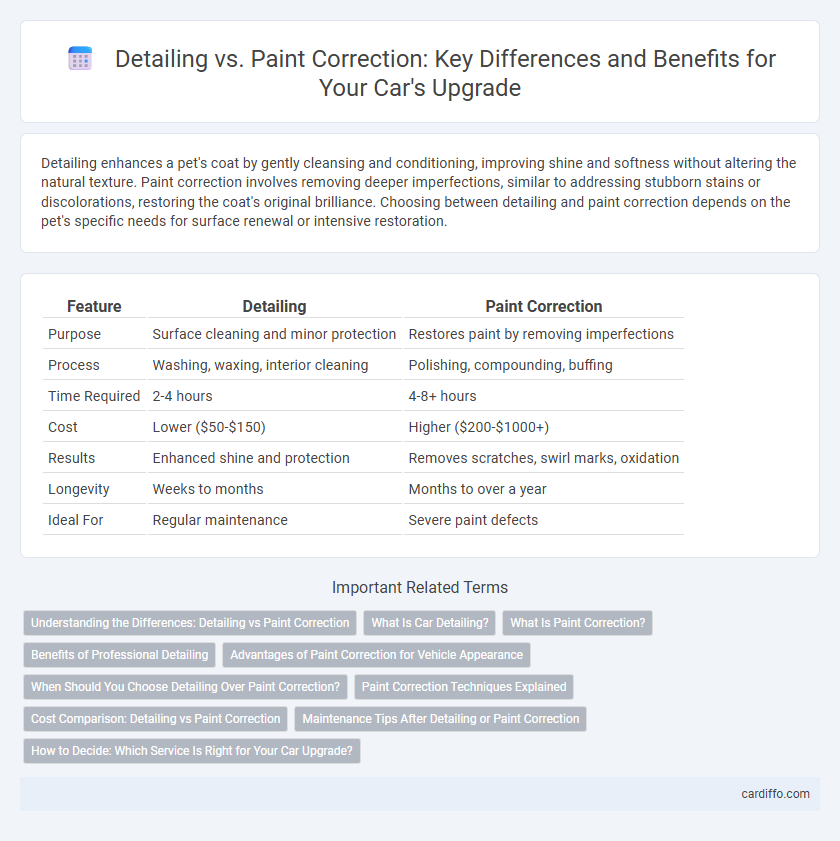Detailing enhances a pet's coat by gently cleansing and conditioning, improving shine and softness without altering the natural texture. Paint correction involves removing deeper imperfections, similar to addressing stubborn stains or discolorations, restoring the coat's original brilliance. Choosing between detailing and paint correction depends on the pet's specific needs for surface renewal or intensive restoration.
Table of Comparison
| Feature | Detailing | Paint Correction |
|---|---|---|
| Purpose | Surface cleaning and minor protection | Restores paint by removing imperfections |
| Process | Washing, waxing, interior cleaning | Polishing, compounding, buffing |
| Time Required | 2-4 hours | 4-8+ hours |
| Cost | Lower ($50-$150) | Higher ($200-$1000+) |
| Results | Enhanced shine and protection | Removes scratches, swirl marks, oxidation |
| Longevity | Weeks to months | Months to over a year |
| Ideal For | Regular maintenance | Severe paint defects |
Understanding the Differences: Detailing vs Paint Correction
Detailing involves thorough cleaning, polishing, and protecting all surfaces of a vehicle to enhance its appearance and preserve its condition, focusing on maintaining existing paint quality. Paint correction specifically targets imperfections in the vehicle's clear coat such as swirl marks, scratches, and oxidation, using abrasive techniques to restore the paint's smoothness and depth. Understanding the differences ensures the correct approach is chosen for either routine maintenance or addressing significant paint defects.
What Is Car Detailing?
Car detailing involves a thorough cleaning, restoration, and finishing of a vehicle's interior and exterior to enhance its appearance and protect its surfaces. Unlike paint correction, which focuses specifically on repairing paint imperfections such as swirl marks and scratches, detailing encompasses a broader scope including washing, waxing, vacuuming, and conditioning. Professional detailing uses specialized tools and products to restore the car's showroom shine and preserve its value over time.
What Is Paint Correction?
Paint correction is a meticulous process that involves removing surface imperfections such as swirl marks, scratches, oxidation, and water spots from a vehicle's clear coat to restore its original gloss and depth. This technique uses specialized compounds and polishing machines to level the paint surface and enhance the car's appearance. Unlike detailing, which includes cleaning and protecting various components, paint correction specifically targets restoring paint clarity and smoothness.
Benefits of Professional Detailing
Professional detailing enhances a vehicle's appearance by thoroughly cleaning, restoring, and protecting both interior and exterior surfaces, surpassing standard paint correction which primarily focuses on removing scratches and swirl marks. Detailing includes deep cleaning of carpets, upholstery, engine bay, and windows, providing long-lasting protection with wax or ceramic coatings that shield paint from environmental damage. This comprehensive care extends vehicle lifespan, improves resale value, and ensures a showroom-quality finish unmatched by basic paint correction alone.
Advantages of Paint Correction for Vehicle Appearance
Paint correction enhances vehicle appearance by removing surface imperfections such as swirl marks, scratches, and oxidation that detailing alone cannot fully address. This process restores the paint's clarity and depth, resulting in a glossy, mirror-like finish that significantly elevates the car's aesthetic value. Paint correction extends the longevity of the vehicle's paintwork by preparing the surface for protection products, ensuring a smoother and more durable finish.
When Should You Choose Detailing Over Paint Correction?
Choose detailing over paint correction when the vehicle has light surface dirt, minor smudges, or needs routine maintenance to restore its shine without altering the paint itself. Detailing enhances the overall appearance by cleaning, polishing, and protecting surfaces, ideal for preserving the finish without addressing deeper imperfections like scratches or oxidation. Paint correction is better reserved for vehicles exhibiting paint swirl marks, scratches, or other significant defects requiring surface resmoothing.
Paint Correction Techniques Explained
Paint correction techniques involve the meticulous removal of surface imperfections such as swirl marks, oxidation, and scratches using machine polishing combined with various abrasive compounds. These methods enhance the paint's clarity and gloss by restoring the factory finish and eliminating defects without removing excessive clear coat. Professional-grade tools like rotary and dual-action polishers enable precise control over pressure and speed, ensuring optimal results during the correction process.
Cost Comparison: Detailing vs Paint Correction
Detailing typically costs between $50 and $150 depending on the package and vehicle size, offering surface cleaning and minor imperfections removal. Paint correction ranges from $200 to $1,000+, focusing on removing deeper scratches, oxidation, and swirl marks for a more extensive restoration. Choosing between detailing and paint correction depends on your budget and the level of paint surface enhancement desired.
Maintenance Tips After Detailing or Paint Correction
To maintain the flawless finish achieved through detailing or paint correction, regularly wash your vehicle using pH-balanced, car-specific shampoos to avoid stripping protective coatings. Apply a high-quality wax or sealant every few months to preserve paint clarity and enhance durability against environmental contaminants. Inspect and promptly address any swirl marks or scratches, employing gentle touch-up techniques to prolong the results of paint correction.
How to Decide: Which Service Is Right for Your Car Upgrade?
Detailing enhances a car's appearance by cleaning, polishing, and protecting all surfaces, preserving the vehicle's condition without aggressive intervention. Paint correction focuses on removing imperfections like swirl marks, scratches, and oxidation through machine polishing, restoring the paint to a near-perfect finish. Choose detailing for maintenance and protection, and opt for paint correction when significant paint defects or damage require restoration for a superior upgrade.
detailing vs paint correction Infographic

 cardiffo.com
cardiffo.com